
chat-with-your-data-solution-accelerator
A Solution Accelerator for the RAG pattern running in Azure, using Azure AI Search for retrieval and Azure OpenAI large language models to power ChatGPT-style and Q&A experiences. This includes most common requirements and best practices.
Stars: 902
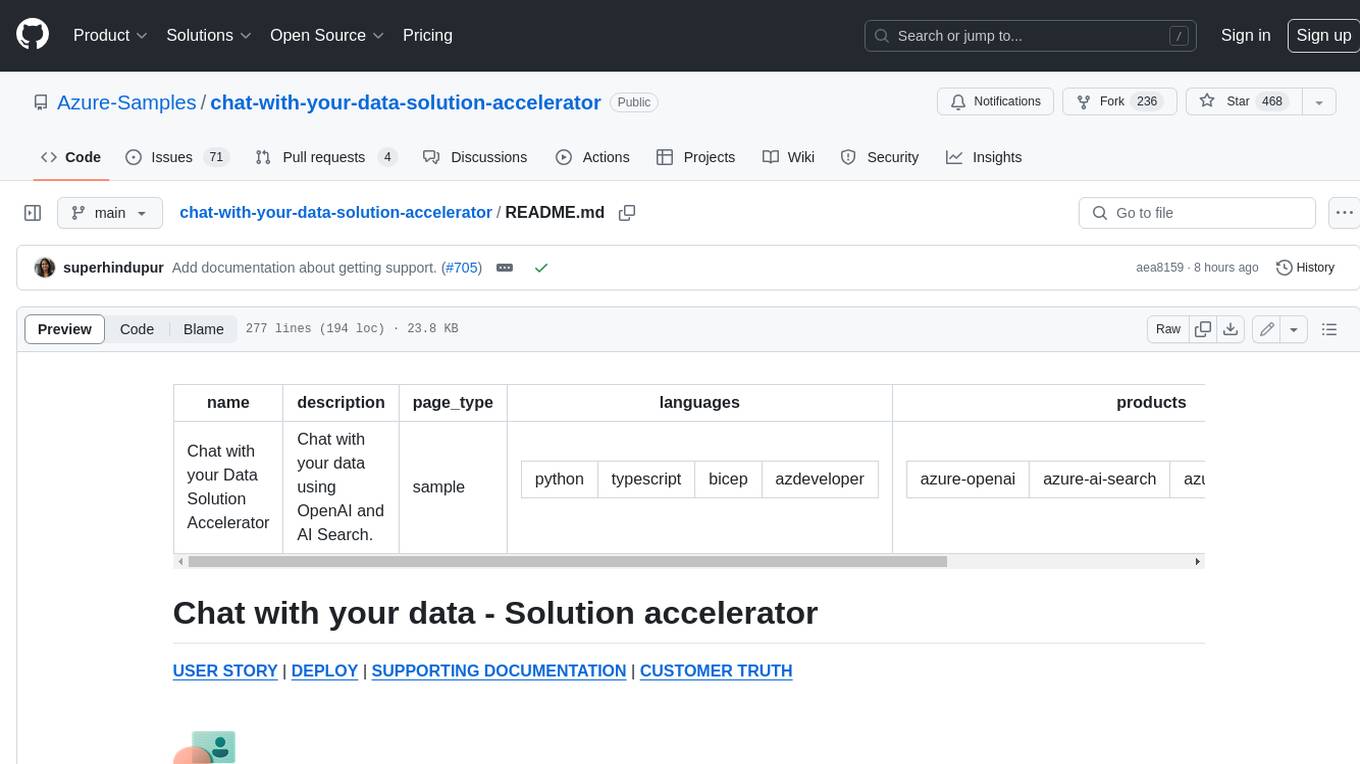
Chat with your data using OpenAI and AI Search. This solution accelerator uses an Azure OpenAI GPT model and an Azure AI Search index generated from your data, which is integrated into a web application to provide a natural language interface, including speech-to-text functionality, for search queries. Users can drag and drop files, point to storage, and take care of technical setup to transform documents. There is a web app that users can create in their own subscription with security and authentication.
README:
name: Chat with your data - Solution accelerator (Python) description: Chat with your data using OpenAI and AI Search with Python. languages:
- python
- typescript
- bicep
- azdeveloper products:
- azure-openai
- azure-cognitive-search
- azure-app-service
- azure
- azure-bot-service
- document-intelligence
- azure-functions
- azure-storage-accounts
- azure-speech page_type: sample urlFragment: chat-with-your-data-solution-accelerator
Welcome to the Chat with your data Solution accelerator repository! The Chat with your data Solution accelerator is a powerful tool that combines the capabilities of Azure AI Search and Large Language Models (LLMs) to create a conversational search experience. This solution accelerator uses an Azure OpenAI GPT model and an Azure AI Search index generated from your data, which is integrated into a web application to provide a natural language interface, including speech-to-text functionality, for search queries. Users can drag and drop files, point to storage, and take care of technical setup to transform documents. Everything can be deployed in your own subscription to accelerate your use of this technology.
This repository provides an end-to-end solution for users who want to query their data with natural language. It includes a well designed ingestion mechanism for multiple file types, an easy deployment, and a support team for maintenance. The accelerator demonstrates both Push or Pull Ingestion; the choice of orchestration (Semantic Kernel, LangChain, OpenAI Functions or Prompt Flow) and should be the minimum components needed to implement a RAG pattern. It is not intended to be put into Production as-is without experimentation or evaluation of your data. It provides the following features:
- Chat with an Azure OpenAI model using your own data
- Upload and process your documents
- Index public web pages
- Easy prompt configuration
- Multiple chunking strategies
If you need to customize your scenario beyond what Azure OpenAI on your data offers out-of-the-box, use this repository. By default, this repo comes with one specific set of RAG configurations including but not limited to: chunk size, overlap, retrieval/search type and system prompt. It is important that you evaluate the retrieval/search and the generation of the answers for your data and tune these configurations accordingly before you use this repo in production. For a starting point to understand and perform RAG evaluations, we encourage you to look into the RAG Experiment Accelerator.
The accelerator presented here provides several options, for example:
- The ability to ground a model using both data and public web pages
- A backend with support for 'custom' and 'On Your Data' conversation flows
- Advanced prompt engineering capabilities
- An admin site for ingesting/inspecting/configuring your dataset on the fly
- Push or Pull model for data ingestion: See integrated vectorization documentation for more details
- Running a Retrieval Augmented Generation (RAG) solution locally
*Have you seen ChatGPT + Enterprise data with Azure OpenAI and AI Search demo? If you would like to experiment: Play with prompts, understanding RAG pattern different implementation approaches, see how different features interact with the RAG pattern and choose the best options for your RAG deployments, take a look at that repo.
Here is a comparison table with a few features offered by Azure, an available GitHub demo sample and this repo, that can provide guidance when you need to decide which one to use:
| Name | Feature or Sample? | What is it? | When to use? |
|---|---|---|---|
| "Chat with your data" Solution Accelerator - (This repo) | Azure sample | End-to-end baseline RAG pattern sample that uses Azure AI Search as a retriever. | This sample should be used by Developers when the RAG pattern implementations provided by Azure are not able to satisfy business requirements. This sample provides a means to customize the solution. Developers must add their own code to meet requirements, and adapt with best practices according to individual company policies. |
| Azure OpenAI on your data | Azure feature | Azure OpenAI Service offers out-of-the-box, end-to-end RAG implementation that uses a REST API or the web-based interface in the Azure AI Studio to create a solution that connects to your data to enable an enhanced chat experience with Azure OpenAI ChatGPT models and Azure AI Search. | This should be the first option considered for developers that need an end-to-end solution for Azure OpenAI Service with an Azure AI Search retriever. Simply select supported data sources, that ChatGPT model in Azure OpenAI Service , and any other Azure resources needed to configure your enterprise application needs. |
| Azure Machine Learning prompt flow | Azure feature | RAG in Azure Machine Learning is enabled by integration with Azure OpenAI Service for large language models and vectorization. It includes support for Faiss and Azure AI Search as vector stores, as well as support for open-source offerings, tools, and frameworks such as LangChain for data chunking. Azure Machine Learning prompt flow offers the ability to test data generation, automate prompt creation, visualize prompt evaluation metrics, and integrate RAG workflows into MLOps using pipelines. | When Developers need more control over processes involved in the development cycle of LLM-based AI applications, they should use Azure Machine Learning prompt flow to create executable flows and evaluate performance through large-scale testing. |
| ChatGPT + Enterprise data with Azure OpenAI and AI Search demo | Azure sample | RAG pattern demo that uses Azure AI Search as a retriever. | Developers who would like to use or present an end-to-end demonstration of the RAG pattern should use this sample. This includes the ability to deploy and test different retrieval modes, and prompts to support business use cases. |
| RAG Experiment Accelerator | Tool | The RAG Experiment Accelerator is a versatile tool that helps you conduct experiments and evaluations using Azure AI Search and RAG pattern. | RAG Experiment Accelerator is to make it easier and faster to run experiments and evaluations of search queries and quality of response from OpenAI. This tool is useful for researchers, data scientists, and developers who want to, Test the performance of different Search and OpenAI related hyperparameters. |
- Private LLM access on your data: Get all the benefits of ChatGPT on your private, unstructured data.
- Single application access to your full data set: Minimize endpoints required to access internal company knowledgebases. Reuse the same backend with the Microsoft Teams Extension
- Natural language interaction with your unstructured data: Use natural language to quickly find the answers you need and ask follow-up queries to get the supplemental details, including Speech-to-text.
- Easy access to source documentation when querying: Review referenced documents in the same chat window for additional context.
- Chat history: Prior conversations and context are maintained and accessible through chat history.
- Data upload: Batch upload documents of various file types
- Accessible orchestration: Prompt and document configuration (prompt engineering, document processing, and data retrieval)
- Database flexibility: Dynamic database switching allows users to choose between PostgreSQL and Cosmos DB based on their requirements. If no preference is specified the platform defaults to PostgreSQL.
Note: The current model allows users to ask questions about unstructured data, such as PDF, text, and docx files. See the supported file types.
Company personnel (employees, executives) looking to research against internal unstructured company data would leverage this accelerator using natural language to find what they need quickly.
This accelerator also works across industry and roles and would be suitable for any employee who would like to get quick answers with a ChatGPT experience against their internal unstructured company data.
Tech administrators can use this accelerator to give their colleagues easy access to internal unstructured company data. Admins can customize the system configurator to tailor responses for the intended audience.
The sample data illustrates how this accelerator could be used for an employee onboarding scenario in across industries.
In this scenario, a newly hired employee is in the process of onboarding to their organization. Leveraging the solution accelerator, she navigates through the extensive offerings of her organization’s health and retirement benefits. With the newly integrated chat history capabilities, they can revisit previous conversations, ensuring continuity and context across multiple days of research. This functionality allows the new employee to efficiently gather and consolidate information, streamlining their onboarding experience. For more details, refer to the README.
The sample data illustrates how this accelerator could be used in the financial services industry (FSI).
In this scenario, a financial advisor is preparing for a meeting with a potential client who has expressed interest in Woodgrove Investments’ Emerging Markets Funds. The advisor prepares for the meeting by refreshing their understanding of the emerging markets fund's overall goals and the associated risks.
Now that the financial advisor is more informed about Woodgrove’s Emerging Markets Funds, they're better equipped to respond to questions about this fund from their client.
Additionally, we have implemented a Legal Review and Summarization Assistant scenario to demonstrate how this accelerator can be utilized in any industry. The Legal Review and Summarization Assistant helps professionals manage and interact with a large collection of documents efficiently. For more details, refer to the Contract Review and Summarization Assistant README.
Note: Some of the sample data included with this accelerator was generated using AI and is for illustrative purposes only.
- Azure subscription - Create one for free with owner access.
- Approval to use Azure OpenAI services with your Azure subcription. To apply for approval, see here.
- Enable custom Teams apps and turn on custom app uploading (optional: Teams extension only)
- Azure App Service
- Azure Application Insights
- Azure Bot
- Azure OpenAI
- Azure Document Intelligence
- Azure Function App
- Azure Search Service
- Azure Storage Account
- Azure Speech Service
- Azure CosmosDB
- Azure PostgreSQL
- Teams (optional: Teams extension only)
- Microsoft 365 (optional: Teams extension only)
This solution accelerator deploys multiple resources. Evaluate the cost of each component prior to deployment.
The following are links to the pricing details for some of the resources:
- Azure OpenAI service pricing. GPT and embedding models are charged separately.
- Azure AI Search pricing. AI Search core service and semantic ranker are charged separately.
- Azure Blob Storage pricing
- Azure Functions pricing
- Azure AI Document Intelligence pricing
- Azure Web App Pricing
With the addition of PostgreSQL, customers can leverage the power of a relationship-based AI solution to enhance historical conversation access, improve data privacy, and open the possibilities for scalability.
Customers have the option to deploy this solution with PostgreSQL or Cosmos DB. Consider the following when deciding which database to use:
- PostgreSQL enables a relationship-based AI solution and search indexing for Retrieval Augmented Generation (RAG)
- Cosmos DB enables chat history and is a NoSQL-based solution. With Cosmos DB, Azure AI Search is used for storing extracted documents and embeddings.
To review PostgreSQL configuration overview and steps, follow the link here.

To review Cosmos DB configuration overview and steps, follow the link here.

The "Deploy to Azure" button offers a one-click deployment where you don’t have to clone the code. If you would like a developer experience instead, follow the local deployment instructions.
Once you deploy to Azure, you will have the option to select PostgreSQL or Cosmos DB, see screenshot below.
Select either "PostgreSQL" or "Cosmos DB":

When Deployment is complete, follow steps in Set Up Authentication in Azure App Service to add app authentication to your web app running on Azure App Service
Note: The default configuration deploys an OpenAI Model "gpt-35-turbo" with version 0613. However, not all locations support this version. If you're deploying to a location that doesn't support version 0613, you'll need to switch to a lower version. To find out which versions are supported in different regions, visit the GPT-35 Turbo Model Availability page.
-
Navigate to the admin site, where you can upload documents. It will be located at:
https://web-{RESOURCE_TOKEN}-admin.azurewebsites.net/Where
{RESOURCE_TOKEN}is uniquely generated during deployment. This is a combination of your subscription and the name of the resource group. Then select Ingest Data and add your data. You can find sample data in the/datadirectory. -
Navigate to the web app to start chatting on top of your data. The web app can be found at:
https://web-{RESOURCE_TOKEN}.azurewebsites.net/
This solution accelerator deploys the following resources. It's critical to comprehend the functionality of each. Below are the links to their respective documentation:
- Application Insights overview - Azure Monitor | Microsoft Learn
- Azure OpenAI Service - Documentation, quickstarts, API reference - Azure AI services | Microsoft Learn
- Using your data with Azure OpenAI Service - Azure OpenAI | Microsoft Learn
- Content Safety documentation - Quickstarts, Tutorials, API Reference - Azure AI services | Microsoft Learn
- Document Intelligence documentation - Quickstarts, Tutorials, API Reference - Azure AI services | Microsoft Learn
- Azure Functions documentation | Microsoft Learn
- Azure Cognitive Search documentation | Microsoft Learn
- Speech to text documentation - Tutorials, API Reference - Azure AI services - Azure AI services | Microsoft Learn
- Bots in Microsoft Teams - Teams | Microsoft Learn (Optional: Teams extension only)
This repository is licensed under the MIT License.
The data set under the /data folder is licensed under the CDLA-Permissive-2 License.
This Software requires the use of third-party components which are governed by separate proprietary or open-source licenses as identified below, and you must comply with the terms of each applicable license in order to use the Software. You acknowledge and agree that this license does not grant you a license or other right to use any such third-party proprietary or open-source components.
To the extent that the Software includes components or code used in or derived from Microsoft products or services, including without limitation Microsoft Azure Services (collectively, “Microsoft Products and Services”), you must also comply with the Product Terms applicable to such Microsoft Products and Services. You acknowledge and agree that the license governing the Software does not grant you a license or other right to use Microsoft Products and Services. Nothing in the license or this ReadMe file will serve to supersede, amend, terminate or modify any terms in the Product Terms for any Microsoft Products and Services.
You must also comply with all domestic and international export laws and regulations that apply to the Software, which include restrictions on destinations, end users, and end use. For further information on export restrictions, visit https://aka.ms/exporting.
You acknowledge that the Software and Microsoft Products and Services (1) are not designed, intended or made available as a medical device(s), and (2) are not designed or intended to be a substitute for professional medical advice, diagnosis, treatment, or judgment and should not be used to replace or as a substitute for professional medical advice, diagnosis, treatment, or judgment. Customer is solely responsible for displaying and/or obtaining appropriate consents, warnings, disclaimers, and acknowledgements to end users of Customer’s implementation of the Online Services.
You acknowledge the Software is not subject to SOC 1 and SOC 2 compliance audits. No Microsoft technology, nor any of its component technologies, including the Software, is intended or made available as a substitute for the professional advice, opinion, or judgement of a certified financial services professional. Do not use the Software to replace, substitute, or provide professional financial advice or judgment.
BY ACCESSING OR USING THE SOFTWARE, YOU ACKNOWLEDGE THAT THE SOFTWARE IS NOT DESIGNED OR INTENDED TO SUPPORT ANY USE IN WHICH A SERVICE INTERRUPTION, DEFECT, ERROR, OR OTHER FAILURE OF THE SOFTWARE COULD RESULT IN THE DEATH OR SERIOUS BODILY INJURY OF ANY PERSON OR IN PHYSICAL OR ENVIRONMENTAL DAMAGE (COLLECTIVELY, “HIGH-RISK USE”), AND THAT YOU WILL ENSURE THAT, IN THE EVENT OF ANY INTERRUPTION, DEFECT, ERROR, OR OTHER FAILURE OF THE SOFTWARE, THE SAFETY OF PEOPLE, PROPERTY, AND THE ENVIRONMENT ARE NOT REDUCED BELOW A LEVEL THAT IS REASONABLY, APPROPRIATE, AND LEGAL, WHETHER IN GENERAL OR IN A SPECIFIC INDUSTRY. BY ACCESSING THE SOFTWARE, YOU FURTHER ACKNOWLEDGE THAT YOUR HIGH-RISK USE OF THE SOFTWARE IS AT YOUR OWN RISK.
For Tasks:
Click tags to check more tools for each tasksFor Jobs:
Alternative AI tools for chat-with-your-data-solution-accelerator
Similar Open Source Tools

chat-with-your-data-solution-accelerator
Chat with your data using OpenAI and AI Search. This solution accelerator uses an Azure OpenAI GPT model and an Azure AI Search index generated from your data, which is integrated into a web application to provide a natural language interface, including speech-to-text functionality, for search queries. Users can drag and drop files, point to storage, and take care of technical setup to transform documents. There is a web app that users can create in their own subscription with security and authentication.
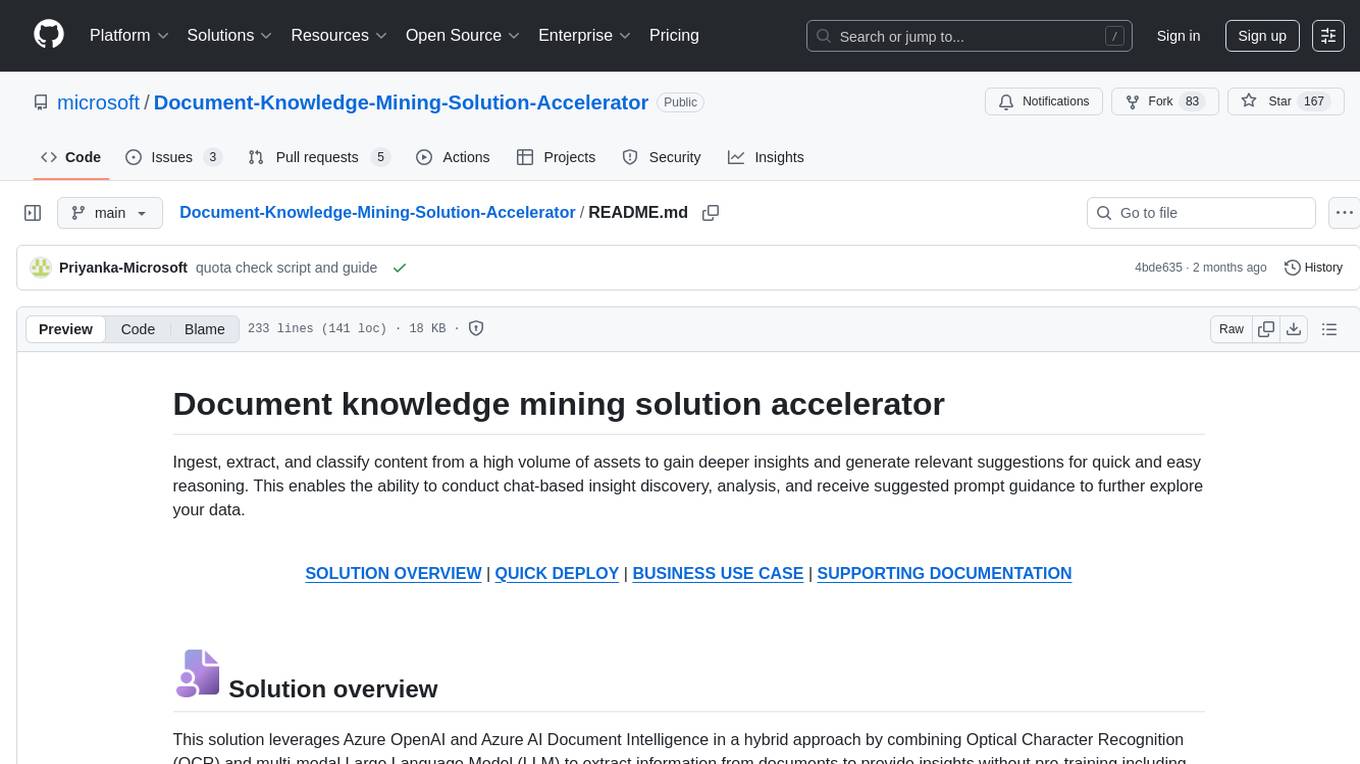
Document-Knowledge-Mining-Solution-Accelerator
The Document Knowledge Mining Solution Accelerator leverages Azure OpenAI and Azure AI Document Intelligence to ingest, extract, and classify content from various assets, enabling chat-based insight discovery, analysis, and prompt guidance. It uses OCR and multi-modal LLM to extract information from documents like text, handwritten text, charts, graphs, tables, and form fields. Users can customize the technical architecture and data processing workflow. Key features include ingesting and extracting real-world entities, chat-based insights discovery, text and document data analysis, prompt suggestion guidance, and multi-modal information processing.
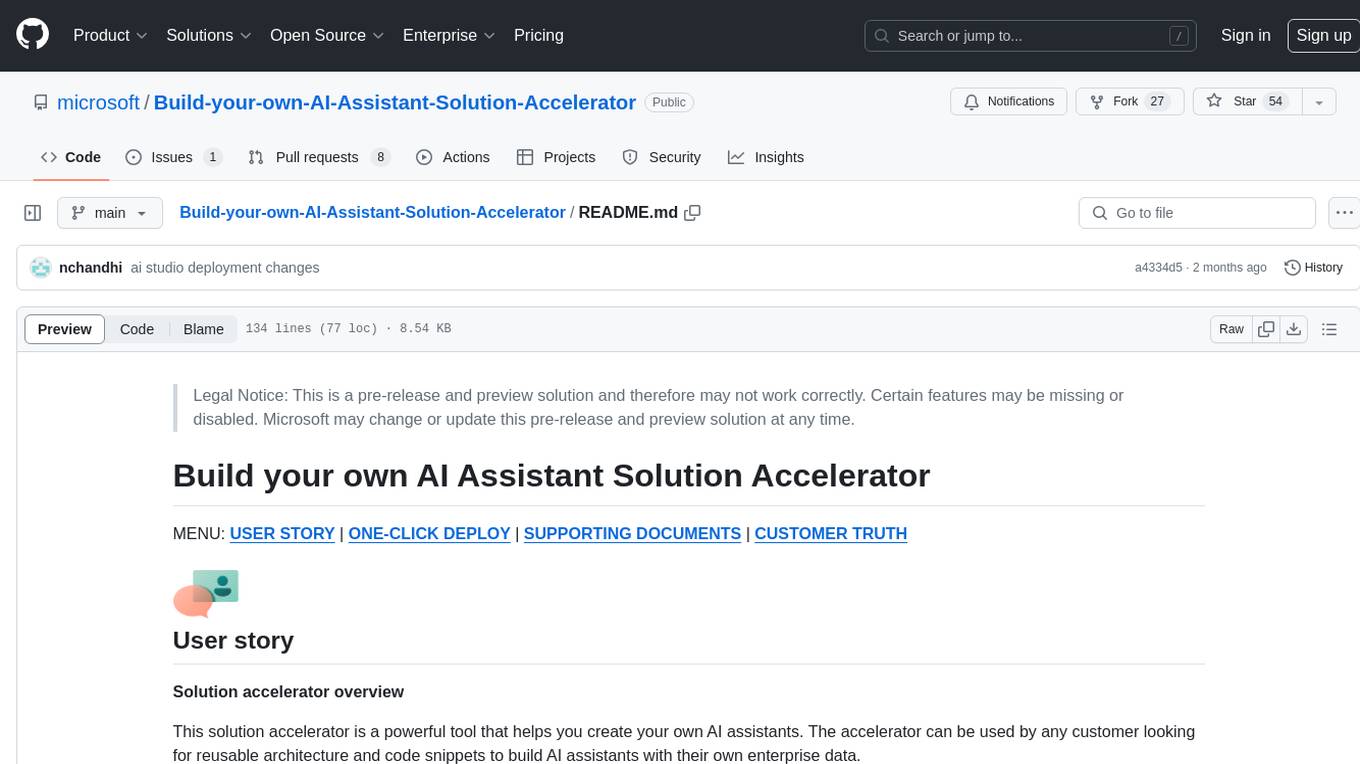
Build-your-own-AI-Assistant-Solution-Accelerator
Build-your-own-AI-Assistant-Solution-Accelerator is a pre-release and preview solution that helps users create their own AI assistants. It leverages Azure Open AI Service, Azure AI Search, and Microsoft Fabric to identify, summarize, and categorize unstructured information. Users can easily find relevant articles and grants, generate grant applications, and export them as PDF or Word documents. The solution accelerator provides reusable architecture and code snippets for building AI assistants with enterprise data. It is designed for researchers looking to explore flu vaccine studies and grants to accelerate grant proposal submissions.
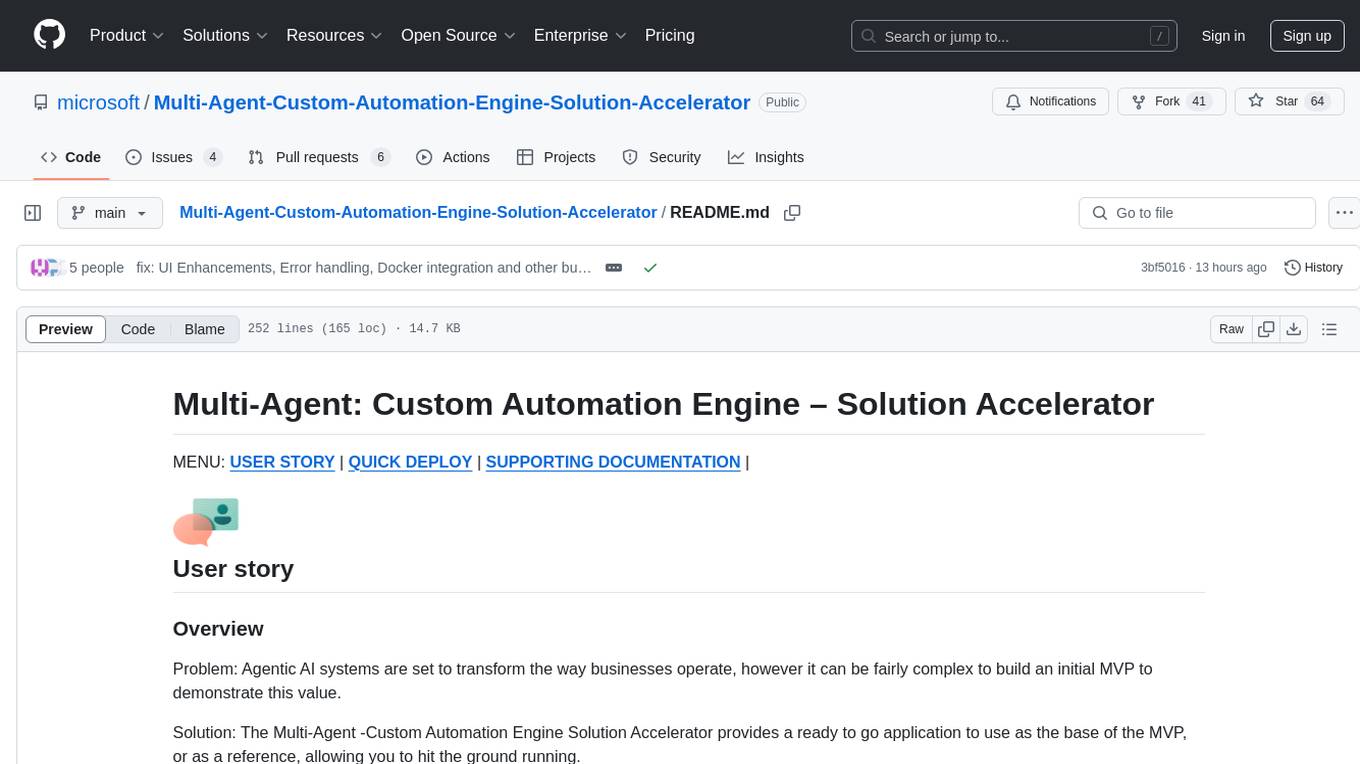
Multi-Agent-Custom-Automation-Engine-Solution-Accelerator
The Multi-Agent -Custom Automation Engine Solution Accelerator is an AI-driven orchestration system that manages a group of AI agents to accomplish tasks based on user input. It uses a FastAPI backend to handle HTTP requests, processes them through various specialized agents, and stores stateful information using Azure Cosmos DB. The system allows users to focus on what matters by coordinating activities across an organization, enabling GenAI to scale, and is applicable to most industries. It is intended for developing and deploying custom AI solutions for specific customers, providing a foundation to accelerate building out multi-agent systems.
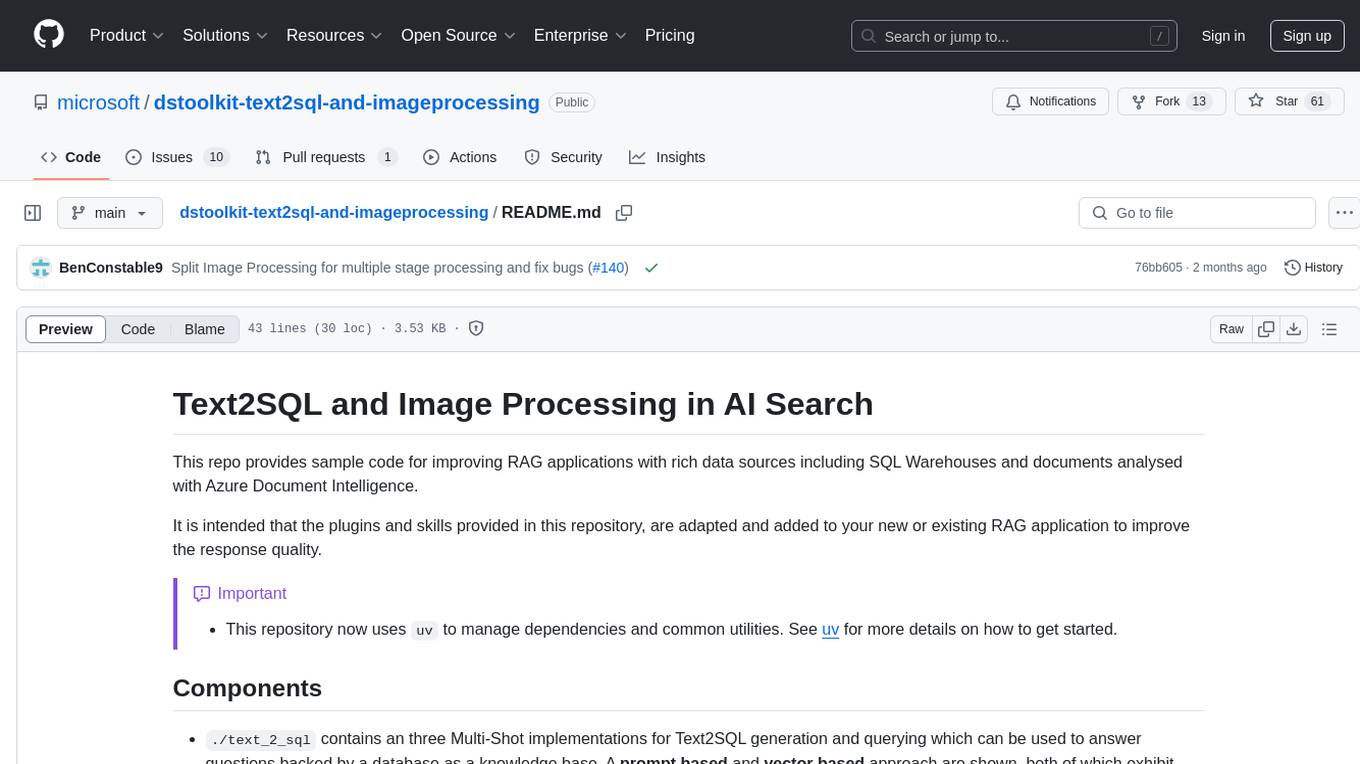
dstoolkit-text2sql-and-imageprocessing
This repository provides sample code for improving RAG applications with rich data sources including SQL Warehouses and documents analysed with Azure Document Intelligence. It includes components for Text2SQL generation and querying, linking Azure Document Intelligence with AI Search for processing complex documents, and deploying AI search indexes. The plugins and skills aim to enhance response quality in RAG applications by accessing and pulling data from SQL tables, drawing insights from complex charts and images, and intelligently grouping similar sentences.
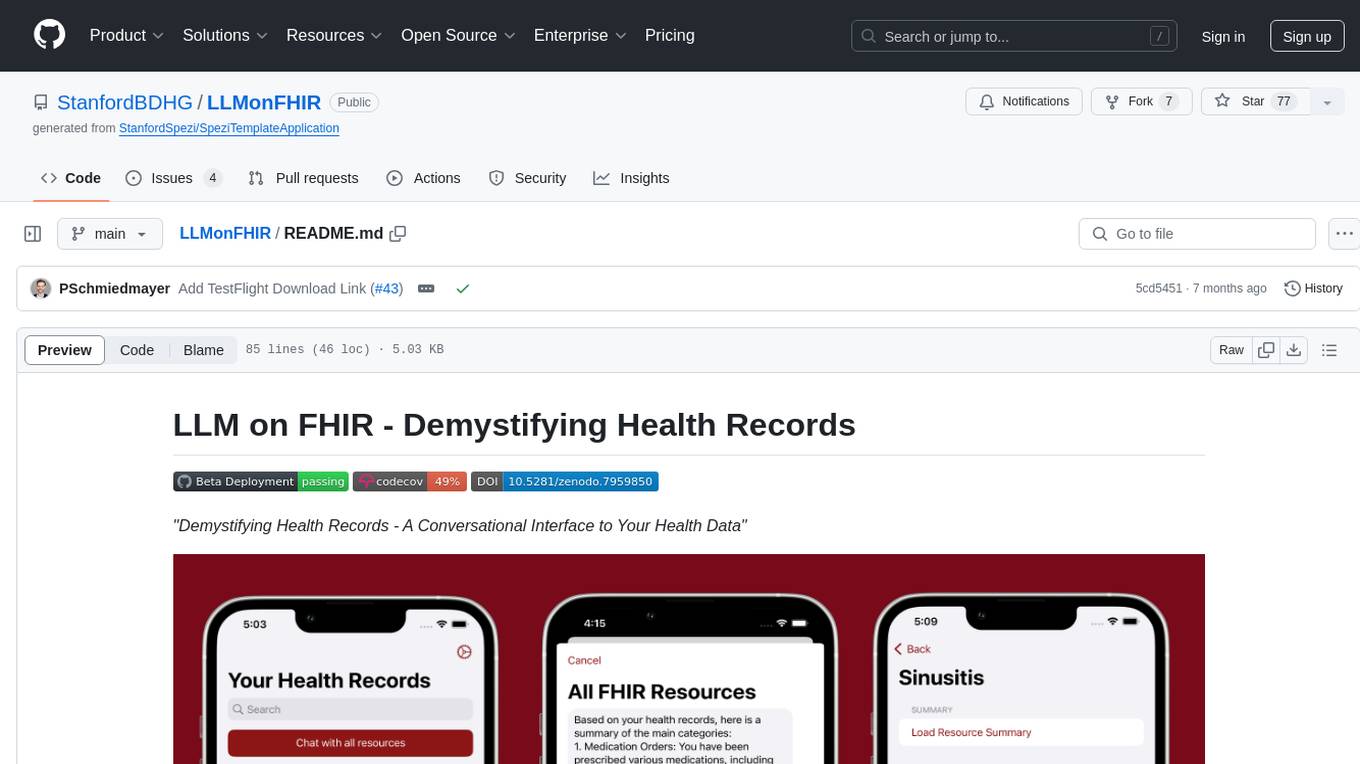
LLMonFHIR
LLMonFHIR is an iOS application that utilizes large language models (LLMs) to interpret and provide context around patient data in the Fast Healthcare Interoperability Resources (FHIR) format. It connects to the OpenAI GPT API to analyze FHIR resources, supports multiple languages, and allows users to interact with their health data stored in the Apple Health app. The app aims to simplify complex health records, provide insights, and facilitate deeper understanding through a conversational interface. However, it is an experimental app for informational purposes only and should not be used as a substitute for professional medical advice. Users are advised to verify information provided by AI models and consult healthcare professionals for personalized advice.
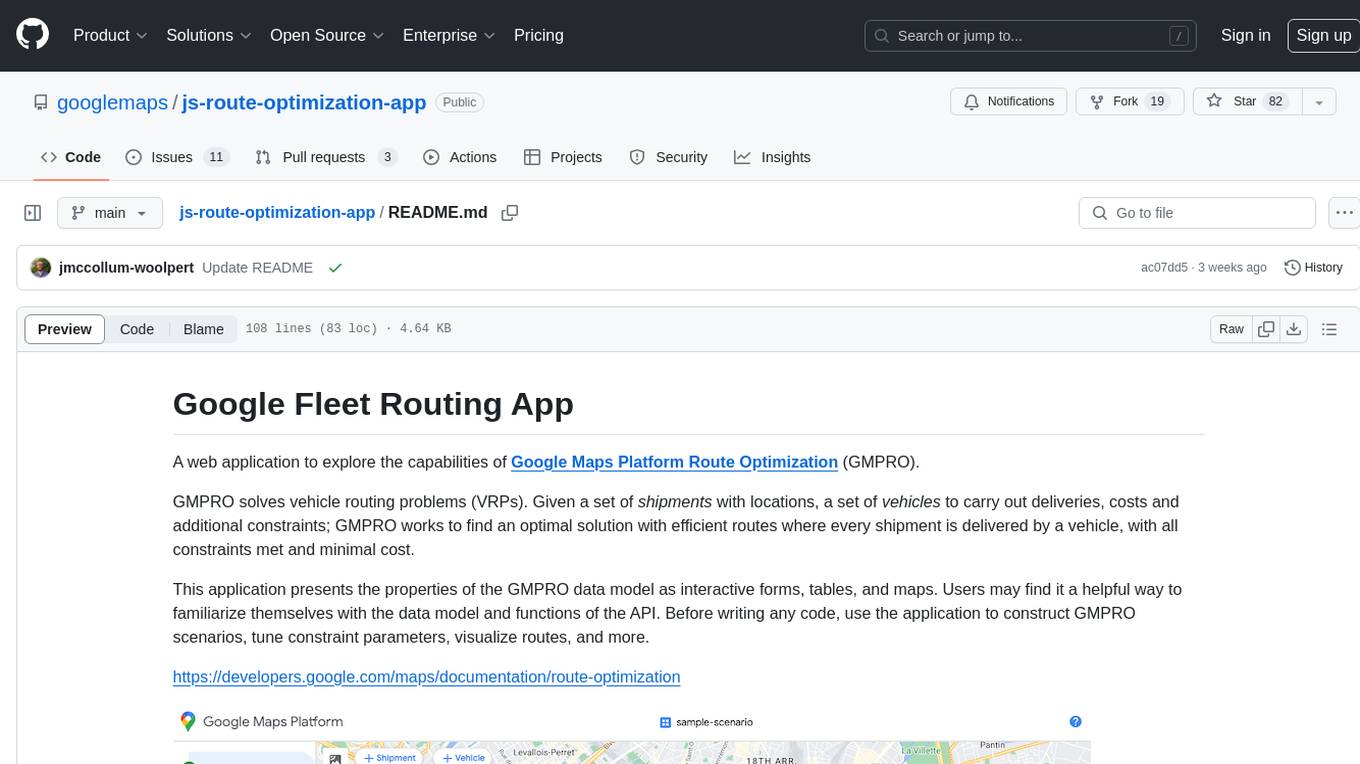
js-route-optimization-app
A web application to explore the capabilities of Google Maps Platform Route Optimization (GMPRO). It helps users understand the data model and functions of the API by presenting interactive forms, tables, and maps. The tool is intended for exploratory use only and should not be deployed in production. Users can construct scenarios, tune constraint parameters, and visualize routes before implementing their own solutions for integrating Route Optimization into their business processes. The application incurs charges related to cloud resources and API usage, and users should be cautious about generating high usage volumes, especially for large scenarios.
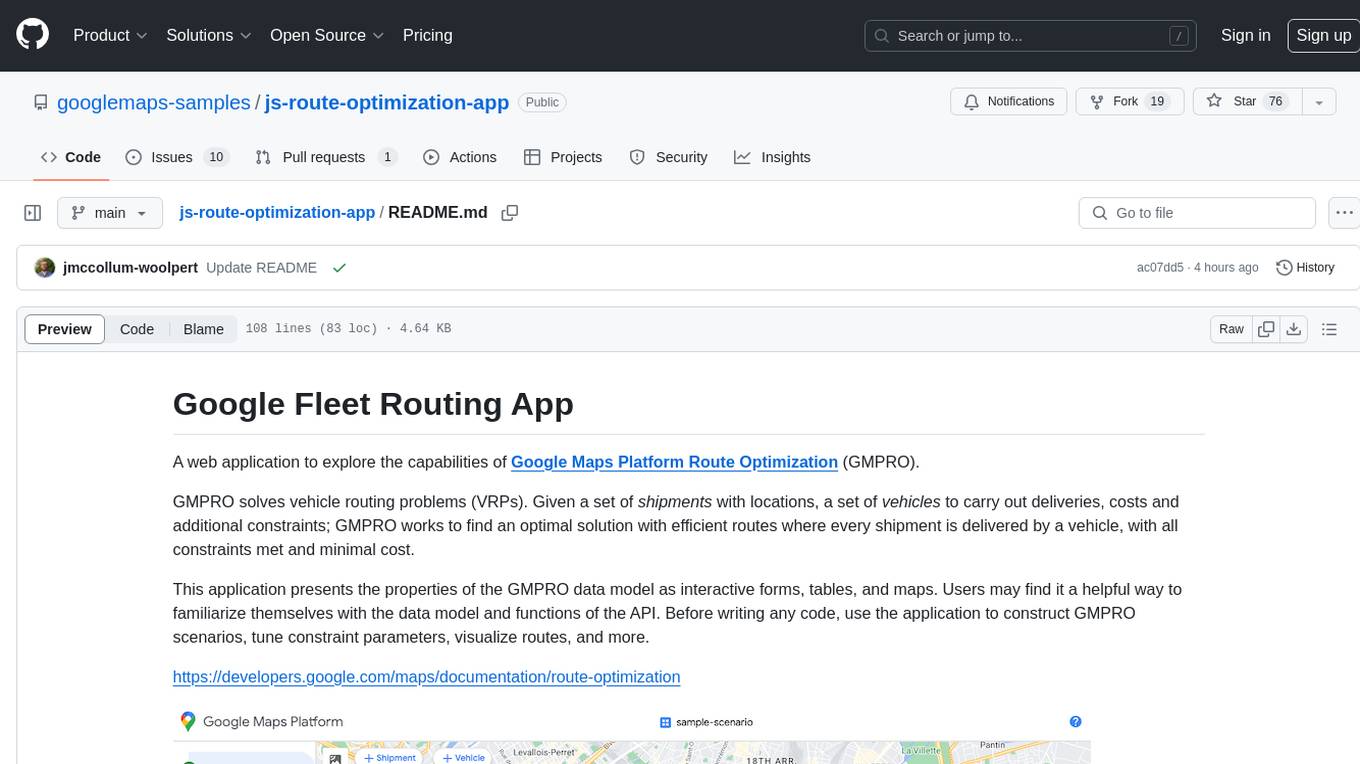
js-route-optimization-app
A web application to explore the capabilities of Google Maps Platform Route Optimization (GMPRO) for solving vehicle routing problems. Users can interact with the GMPRO data model through forms, tables, and maps to construct scenarios, tune constraints, and visualize routes. The application is intended for exploration purposes only and should not be deployed in production. Users are responsible for billing related to cloud resources and API usage. It is important to understand the pricing models for Maps Platform and Route Optimization before using the application.
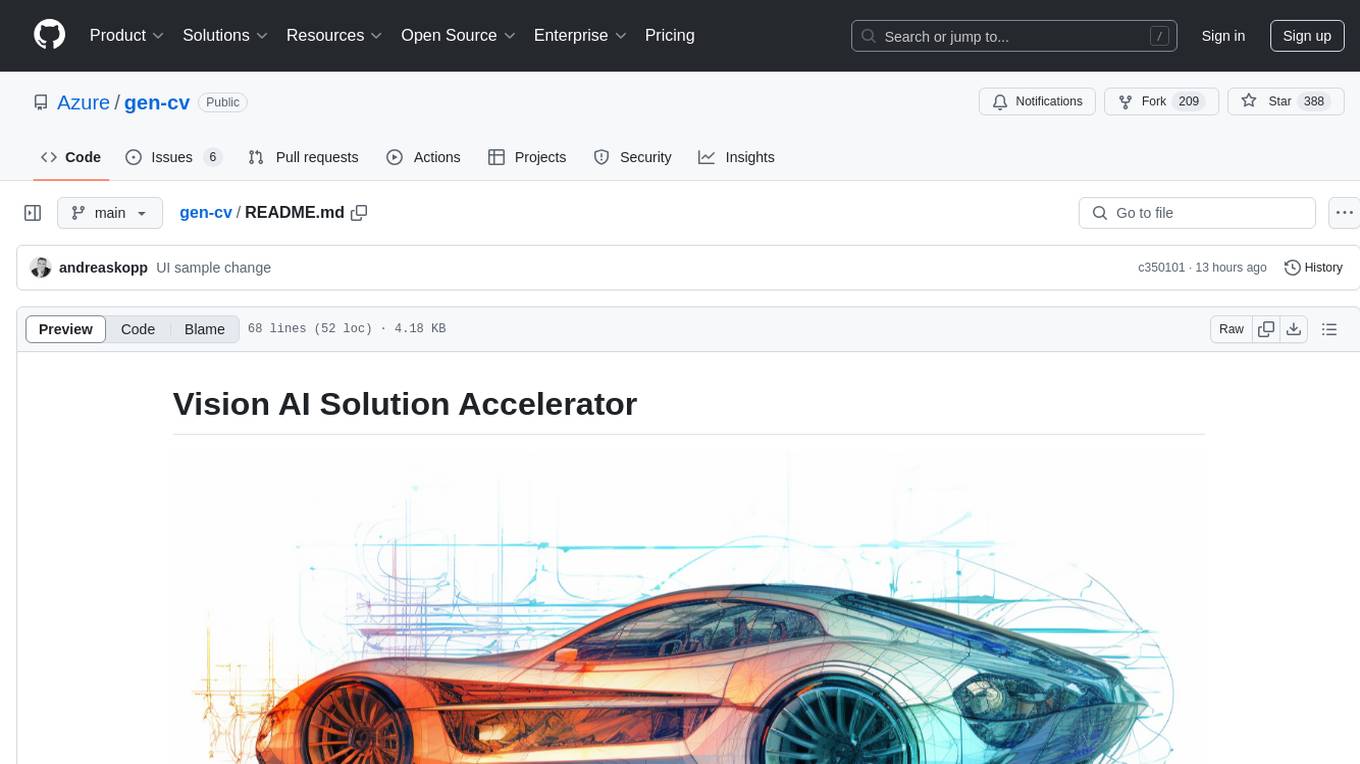
gen-cv
This repository is a rich resource offering examples of synthetic image generation, manipulation, and reasoning using Azure Machine Learning, Computer Vision, OpenAI, and open-source frameworks like Stable Diffusion. It provides practical insights into image processing applications, including content generation, video analysis, avatar creation, and image manipulation with various tools and APIs.
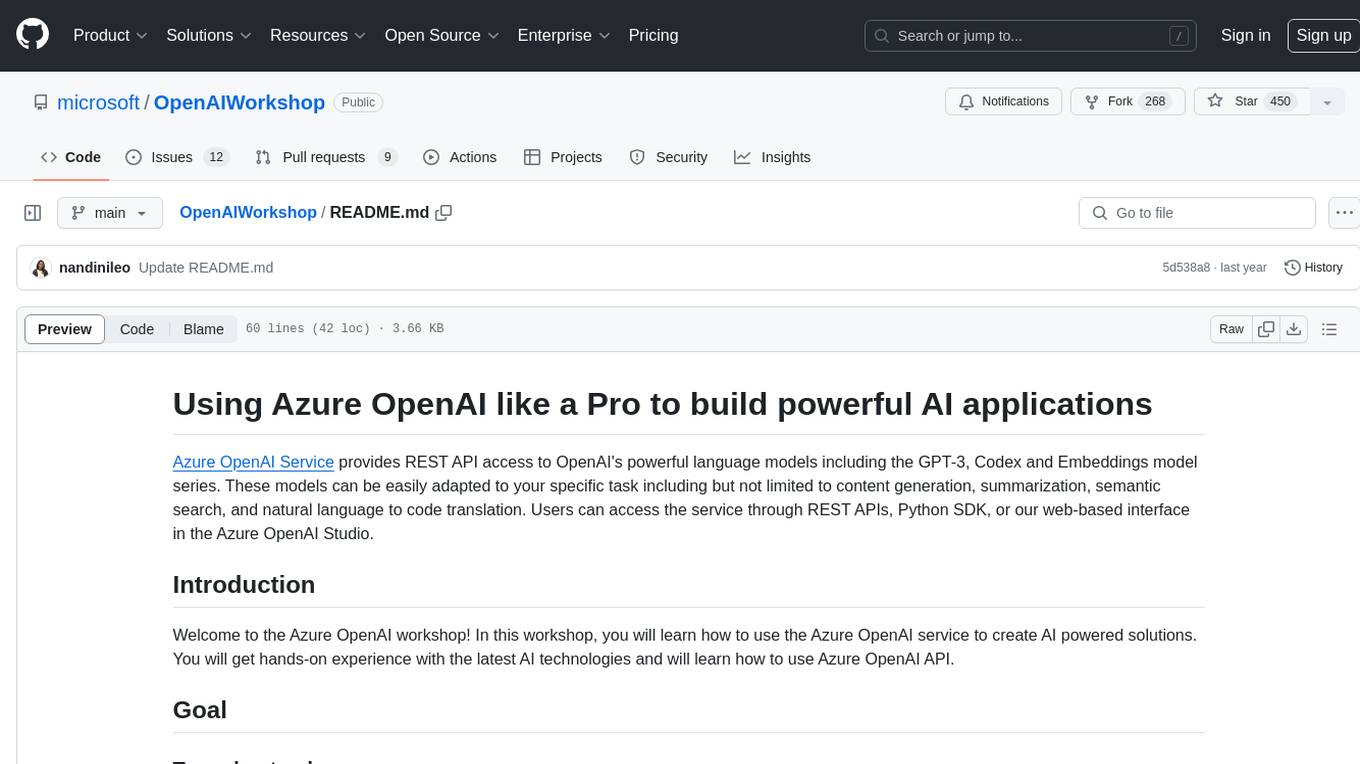
OpenAIWorkshop
Azure OpenAI Service provides REST API access to OpenAI's powerful language models including GPT-3, Codex and Embeddings. Users can easily adapt models for content generation, summarization, semantic search, and natural language to code translation. The workshop covers basics, prompt engineering, common NLP tasks, generative tasks, conversational dialog, and learning methods. It guides users to build applications with PowerApp, query SQL data, create data pipelines, and work with proprietary datasets. Target audience includes Power Users, Software Engineers, Data Scientists, and AI architects and Managers.
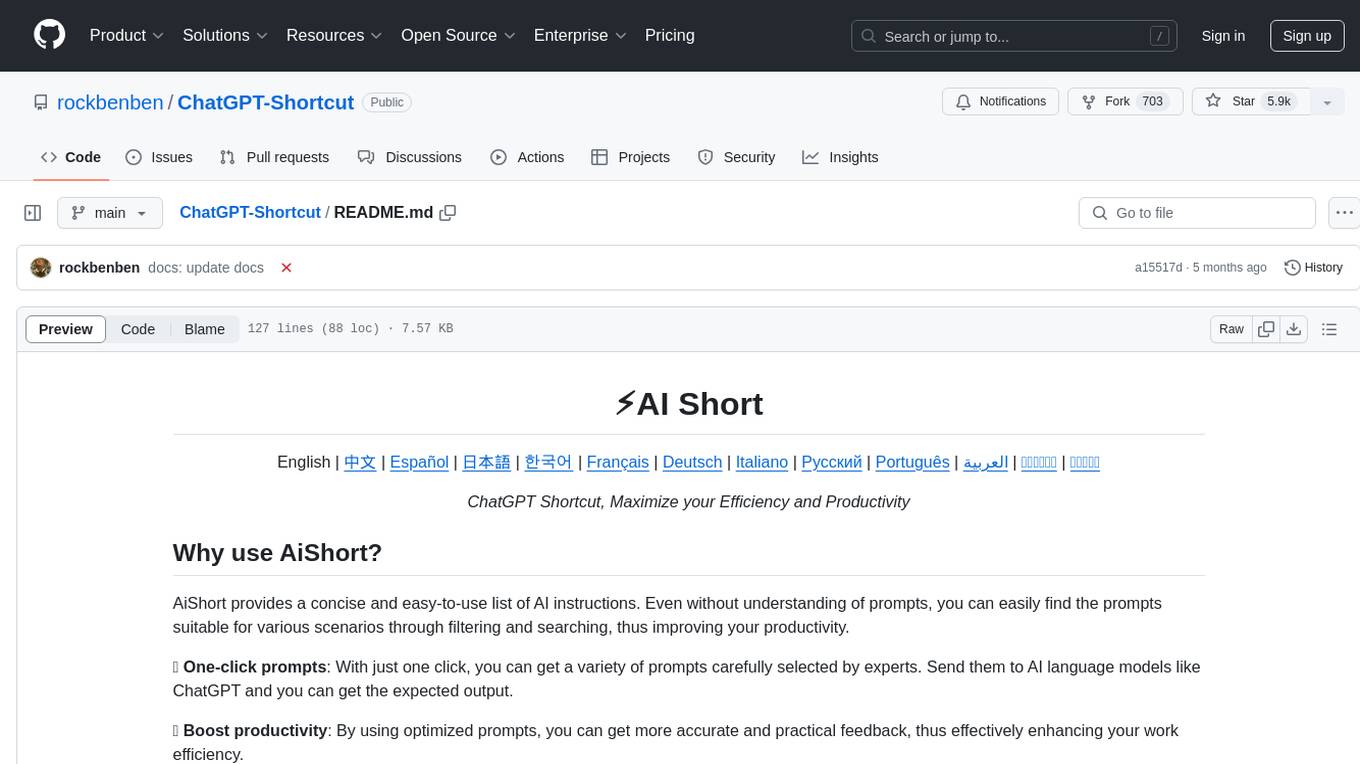
ChatGPT-Shortcut
ChatGPT Shortcut is an AI tool designed to maximize efficiency and productivity by providing a concise list of AI instructions. Users can easily find prompts suitable for various scenarios, boosting productivity and work efficiency. The tool offers one-click prompts, optimization for non-English languages, prompt saving and sharing, and a community voting system. It includes a browser extension compatible with Chrome, Edge, Firefox, and other Chromium-based browsers, as well as a Tampermonkey script for custom domain use. The tool is open-source, allowing users to modify the website's nomenclature, usage directives, and prompts for different languages.
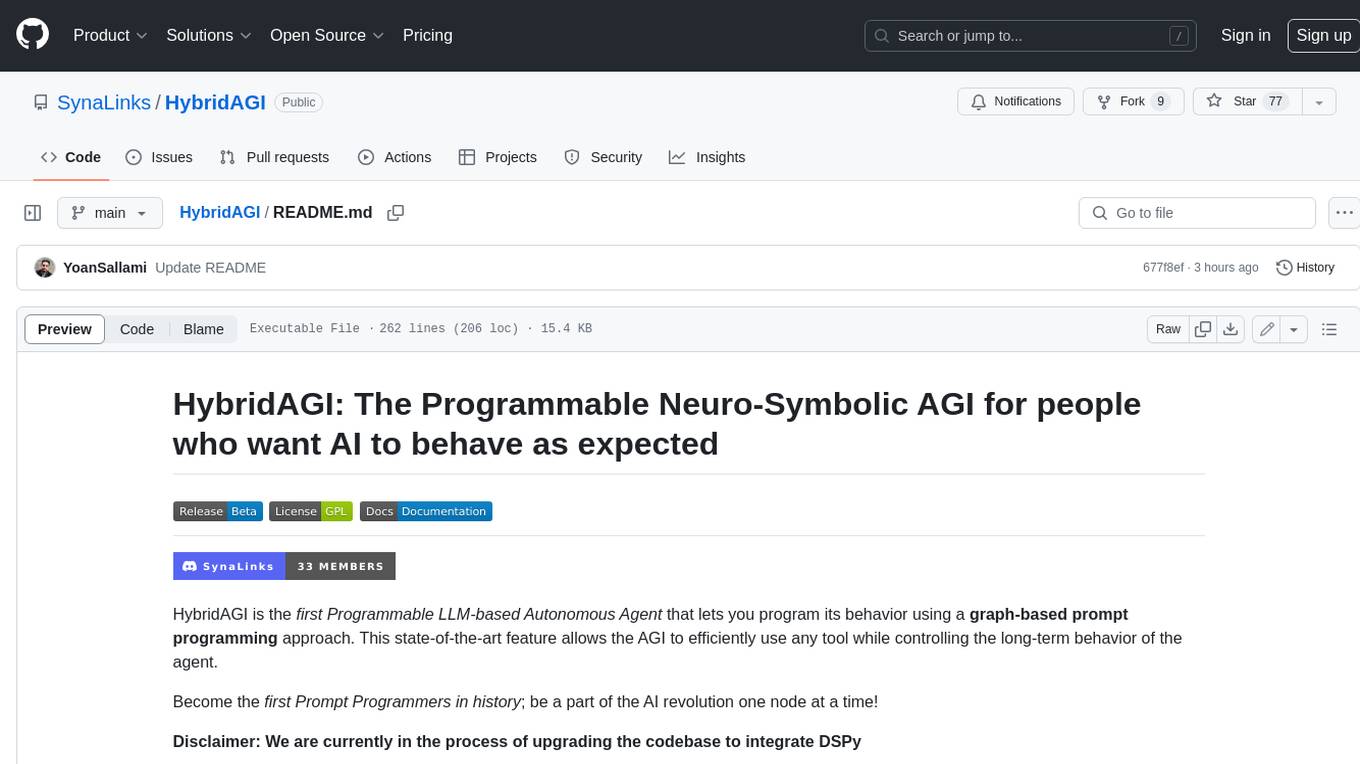
HybridAGI
HybridAGI is the first Programmable LLM-based Autonomous Agent that lets you program its behavior using a **graph-based prompt programming** approach. This state-of-the-art feature allows the AGI to efficiently use any tool while controlling the long-term behavior of the agent. Become the _first Prompt Programmers in history_ ; be a part of the AI revolution one node at a time! **Disclaimer: We are currently in the process of upgrading the codebase to integrate DSPy**
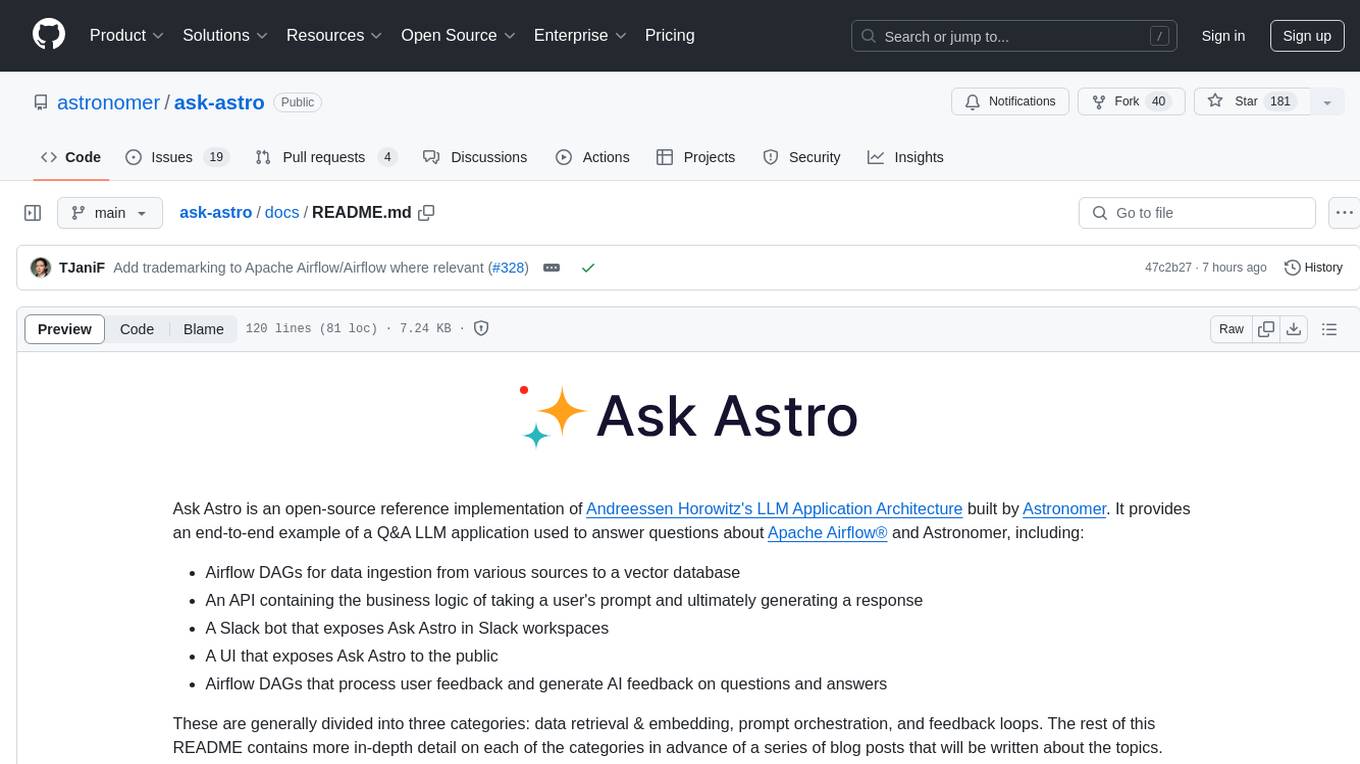
ask-astro
Ask Astro is an open-source reference implementation of Andreessen Horowitz's LLM Application Architecture built by Astronomer. It provides an end-to-end example of a Q&A LLM application used to answer questions about Apache Airflow® and Astronomer. Ask Astro includes Airflow DAGs for data ingestion, an API for business logic, a Slack bot, a public UI, and DAGs for processing user feedback. The tool is divided into data retrieval & embedding, prompt orchestration, and feedback loops.
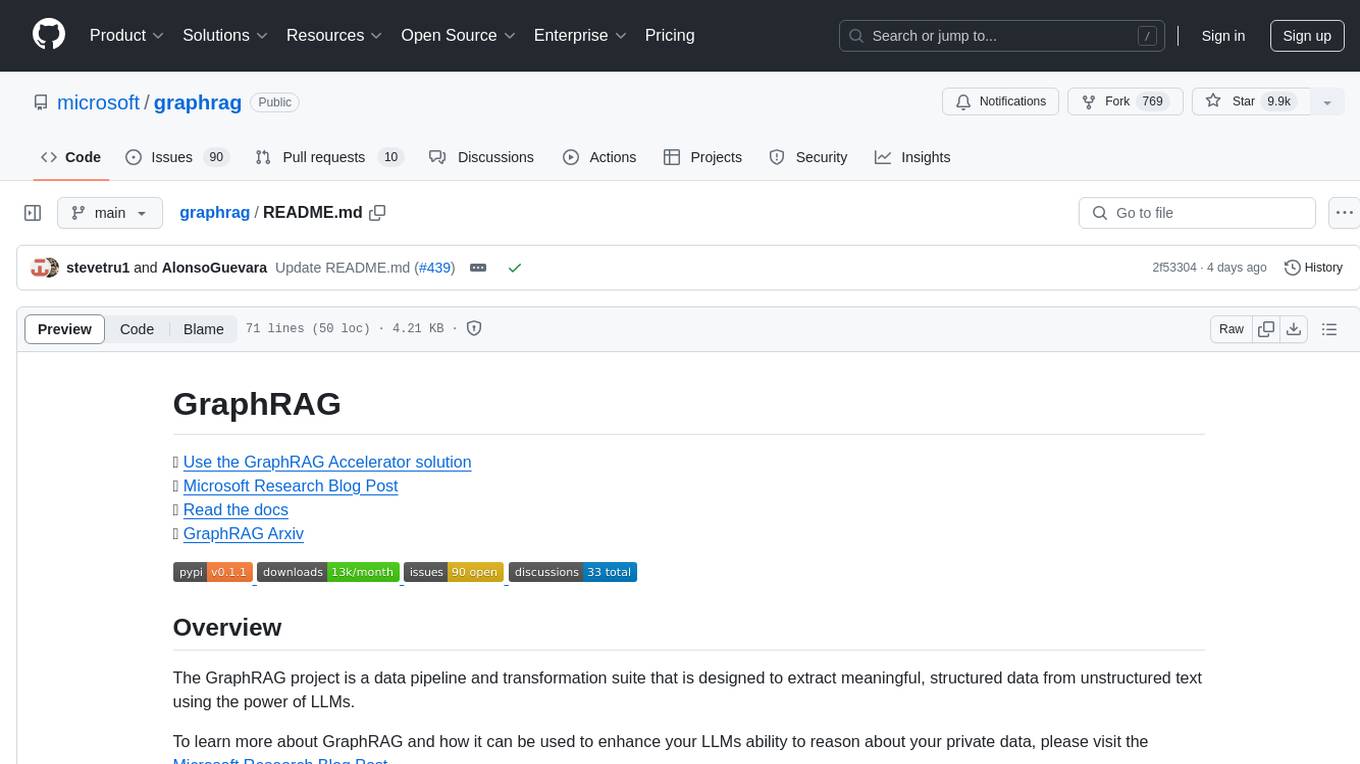
graphrag
The GraphRAG project is a data pipeline and transformation suite designed to extract meaningful, structured data from unstructured text using LLMs. It enhances LLMs' ability to reason about private data. The repository provides guidance on using knowledge graph memory structures to enhance LLM outputs, with a warning about the potential costs of GraphRAG indexing. It offers contribution guidelines, development resources, and encourages prompt tuning for optimal results. The Responsible AI FAQ addresses GraphRAG's capabilities, intended uses, evaluation metrics, limitations, and operational factors for effective and responsible use.
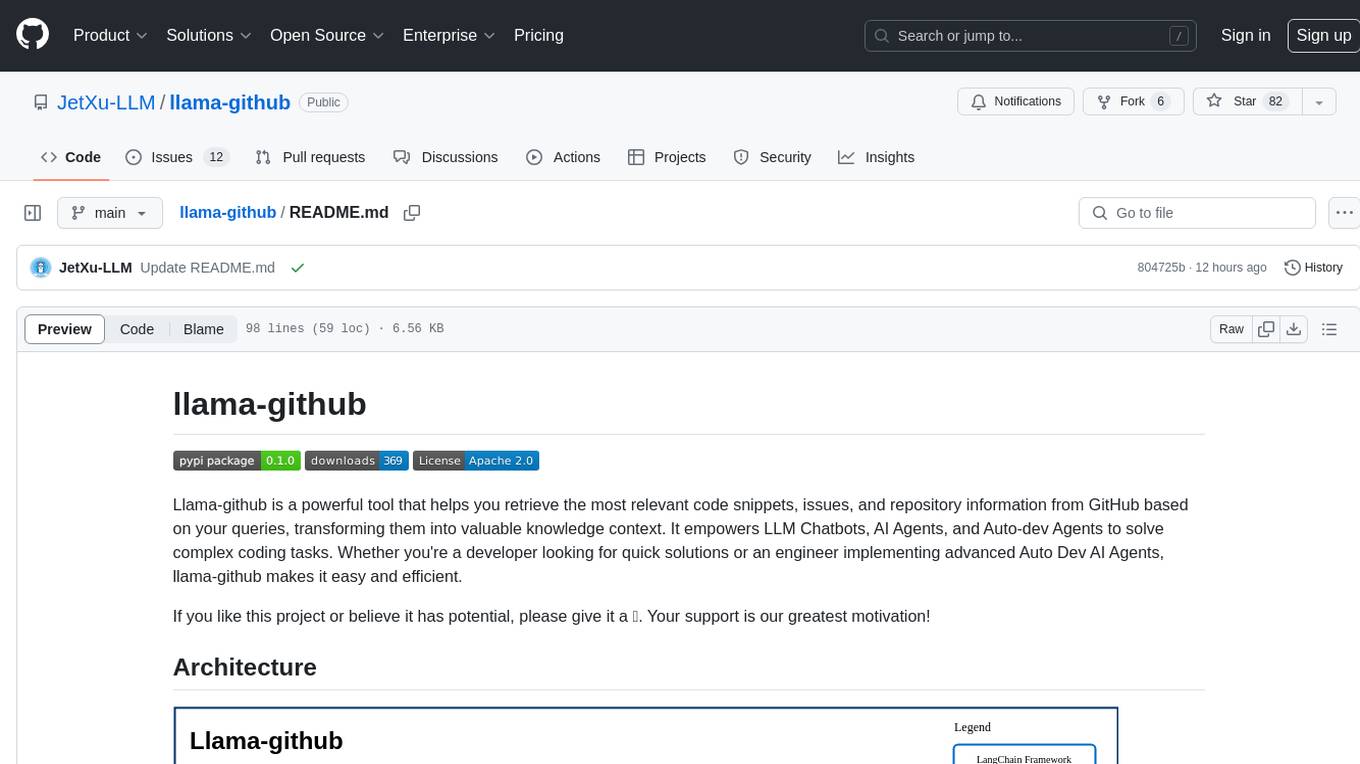
llama-github
Llama-github is a powerful tool that helps retrieve relevant code snippets, issues, and repository information from GitHub based on queries. It empowers AI agents and developers to solve coding tasks efficiently. With features like intelligent GitHub retrieval, repository pool caching, LLM-powered question analysis, and comprehensive context generation, llama-github excels at providing valuable knowledge context for development needs. It supports asynchronous processing, flexible LLM integration, robust authentication options, and logging/error handling for smooth operations and troubleshooting. The vision is to seamlessly integrate with GitHub for AI-driven development solutions, while the roadmap focuses on empowering LLMs to automatically resolve complex coding tasks.
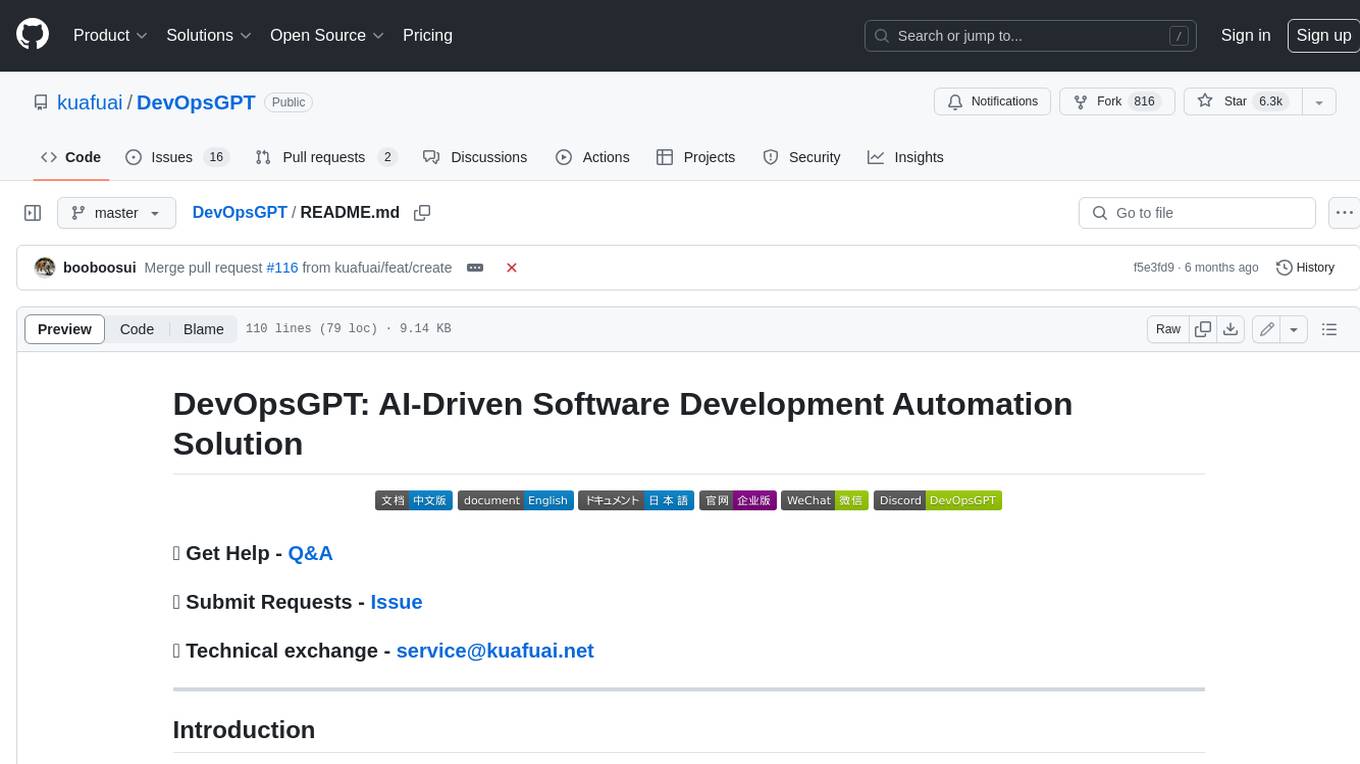
DevOpsGPT
DevOpsGPT is an AI-driven software development automation solution that combines Large Language Models (LLM) with DevOps tools to convert natural language requirements into working software. It improves development efficiency by eliminating the need for tedious requirement documentation, shortens development cycles, reduces communication costs, and ensures high-quality deliverables. The Enterprise Edition offers features like existing project analysis, professional model selection, and support for more DevOps platforms. The tool automates requirement development, generates interface documentation, provides pseudocode based on existing projects, facilitates code refinement, enables continuous integration, and supports software version release. Users can run DevOpsGPT with source code or Docker, and the tool comes with limitations in precise documentation generation and understanding existing project code. The product roadmap includes accurate requirement decomposition, rapid import of development requirements, and integration of more software engineering and professional tools for efficient software development tasks under AI planning and execution.
For similar tasks

LLMStack
LLMStack is a no-code platform for building generative AI agents, workflows, and chatbots. It allows users to connect their own data, internal tools, and GPT-powered models without any coding experience. LLMStack can be deployed to the cloud or on-premise and can be accessed via HTTP API or triggered from Slack or Discord.

ai-guide
This guide is dedicated to Large Language Models (LLMs) that you can run on your home computer. It assumes your PC is a lower-end, non-gaming setup.

onnxruntime-genai
ONNX Runtime Generative AI is a library that provides the generative AI loop for ONNX models, including inference with ONNX Runtime, logits processing, search and sampling, and KV cache management. Users can call a high level `generate()` method, or run each iteration of the model in a loop. It supports greedy/beam search and TopP, TopK sampling to generate token sequences, has built in logits processing like repetition penalties, and allows for easy custom scoring.

jupyter-ai
Jupyter AI connects generative AI with Jupyter notebooks. It provides a user-friendly and powerful way to explore generative AI models in notebooks and improve your productivity in JupyterLab and the Jupyter Notebook. Specifically, Jupyter AI offers: * An `%%ai` magic that turns the Jupyter notebook into a reproducible generative AI playground. This works anywhere the IPython kernel runs (JupyterLab, Jupyter Notebook, Google Colab, Kaggle, VSCode, etc.). * A native chat UI in JupyterLab that enables you to work with generative AI as a conversational assistant. * Support for a wide range of generative model providers, including AI21, Anthropic, AWS, Cohere, Gemini, Hugging Face, NVIDIA, and OpenAI. * Local model support through GPT4All, enabling use of generative AI models on consumer grade machines with ease and privacy.

khoj
Khoj is an open-source, personal AI assistant that extends your capabilities by creating always-available AI agents. You can share your notes and documents to extend your digital brain, and your AI agents have access to the internet, allowing you to incorporate real-time information. Khoj is accessible on Desktop, Emacs, Obsidian, Web, and Whatsapp, and you can share PDF, markdown, org-mode, notion files, and GitHub repositories. You'll get fast, accurate semantic search on top of your docs, and your agents can create deeply personal images and understand your speech. Khoj is self-hostable and always will be.

langchain_dart
LangChain.dart is a Dart port of the popular LangChain Python framework created by Harrison Chase. LangChain provides a set of ready-to-use components for working with language models and a standard interface for chaining them together to formulate more advanced use cases (e.g. chatbots, Q&A with RAG, agents, summarization, extraction, etc.). The components can be grouped into a few core modules: * **Model I/O:** LangChain offers a unified API for interacting with various LLM providers (e.g. OpenAI, Google, Mistral, Ollama, etc.), allowing developers to switch between them with ease. Additionally, it provides tools for managing model inputs (prompt templates and example selectors) and parsing the resulting model outputs (output parsers). * **Retrieval:** assists in loading user data (via document loaders), transforming it (with text splitters), extracting its meaning (using embedding models), storing (in vector stores) and retrieving it (through retrievers) so that it can be used to ground the model's responses (i.e. Retrieval-Augmented Generation or RAG). * **Agents:** "bots" that leverage LLMs to make informed decisions about which available tools (such as web search, calculators, database lookup, etc.) to use to accomplish the designated task. The different components can be composed together using the LangChain Expression Language (LCEL).

danswer
Danswer is an open-source Gen-AI Chat and Unified Search tool that connects to your company's docs, apps, and people. It provides a Chat interface and plugs into any LLM of your choice. Danswer can be deployed anywhere and for any scale - on a laptop, on-premise, or to cloud. Since you own the deployment, your user data and chats are fully in your own control. Danswer is MIT licensed and designed to be modular and easily extensible. The system also comes fully ready for production usage with user authentication, role management (admin/basic users), chat persistence, and a UI for configuring Personas (AI Assistants) and their Prompts. Danswer also serves as a Unified Search across all common workplace tools such as Slack, Google Drive, Confluence, etc. By combining LLMs and team specific knowledge, Danswer becomes a subject matter expert for the team. Imagine ChatGPT if it had access to your team's unique knowledge! It enables questions such as "A customer wants feature X, is this already supported?" or "Where's the pull request for feature Y?"

infinity
Infinity is an AI-native database designed for LLM applications, providing incredibly fast full-text and vector search capabilities. It supports a wide range of data types, including vectors, full-text, and structured data, and offers a fused search feature that combines multiple embeddings and full text. Infinity is easy to use, with an intuitive Python API and a single-binary architecture that simplifies deployment. It achieves high performance, with 0.1 milliseconds query latency on million-scale vector datasets and up to 15K QPS.
For similar jobs

Azure-Analytics-and-AI-Engagement
The Azure-Analytics-and-AI-Engagement repository provides packaged Industry Scenario DREAM Demos with ARM templates (Containing a demo web application, Power BI reports, Synapse resources, AML Notebooks etc.) that can be deployed in a customer’s subscription using the CAPE tool within a matter of few hours. Partners can also deploy DREAM Demos in their own subscriptions using DPoC.
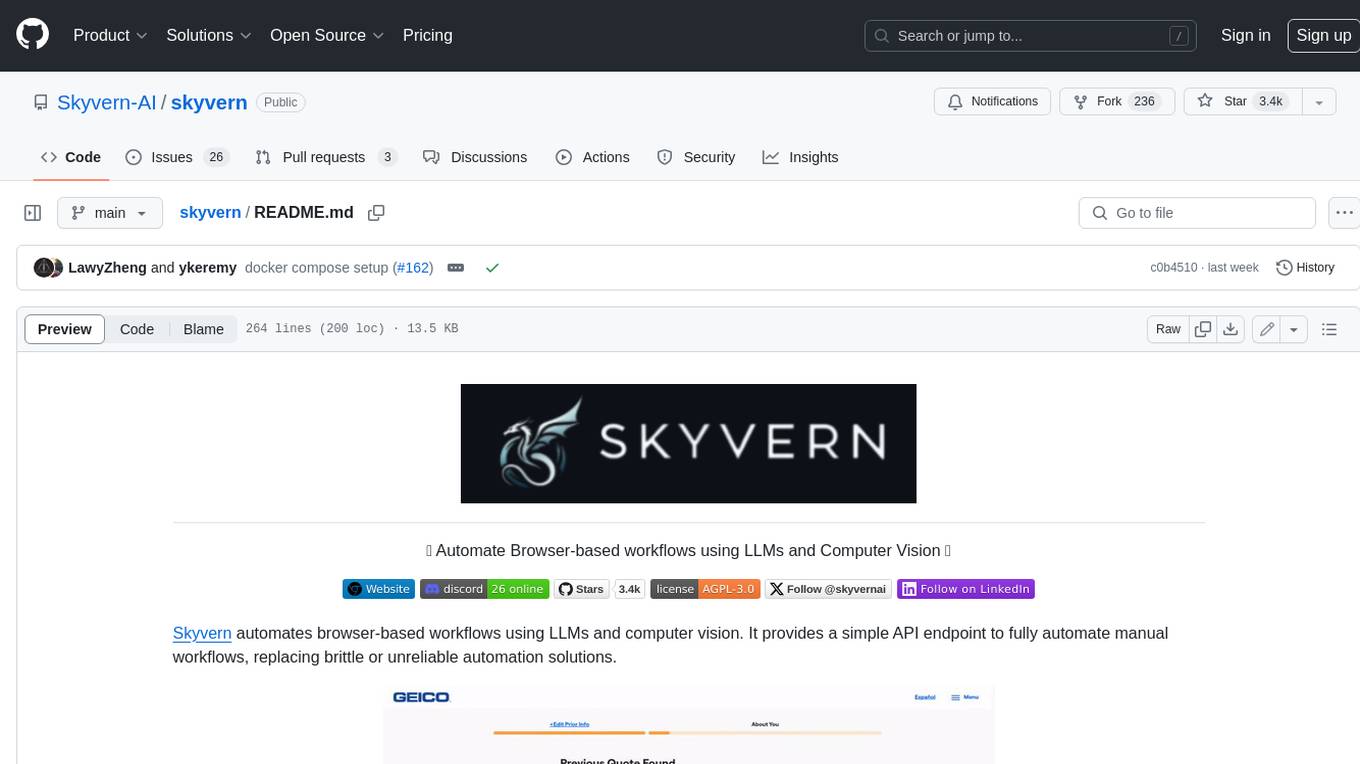
skyvern
Skyvern automates browser-based workflows using LLMs and computer vision. It provides a simple API endpoint to fully automate manual workflows, replacing brittle or unreliable automation solutions. Traditional approaches to browser automations required writing custom scripts for websites, often relying on DOM parsing and XPath-based interactions which would break whenever the website layouts changed. Instead of only relying on code-defined XPath interactions, Skyvern adds computer vision and LLMs to the mix to parse items in the viewport in real-time, create a plan for interaction and interact with them. This approach gives us a few advantages: 1. Skyvern can operate on websites it’s never seen before, as it’s able to map visual elements to actions necessary to complete a workflow, without any customized code 2. Skyvern is resistant to website layout changes, as there are no pre-determined XPaths or other selectors our system is looking for while trying to navigate 3. Skyvern leverages LLMs to reason through interactions to ensure we can cover complex situations. Examples include: 1. If you wanted to get an auto insurance quote from Geico, the answer to a common question “Were you eligible to drive at 18?” could be inferred from the driver receiving their license at age 16 2. If you were doing competitor analysis, it’s understanding that an Arnold Palmer 22 oz can at 7/11 is almost definitely the same product as a 23 oz can at Gopuff (even though the sizes are slightly different, which could be a rounding error!) Want to see examples of Skyvern in action? Jump to #real-world-examples-of- skyvern
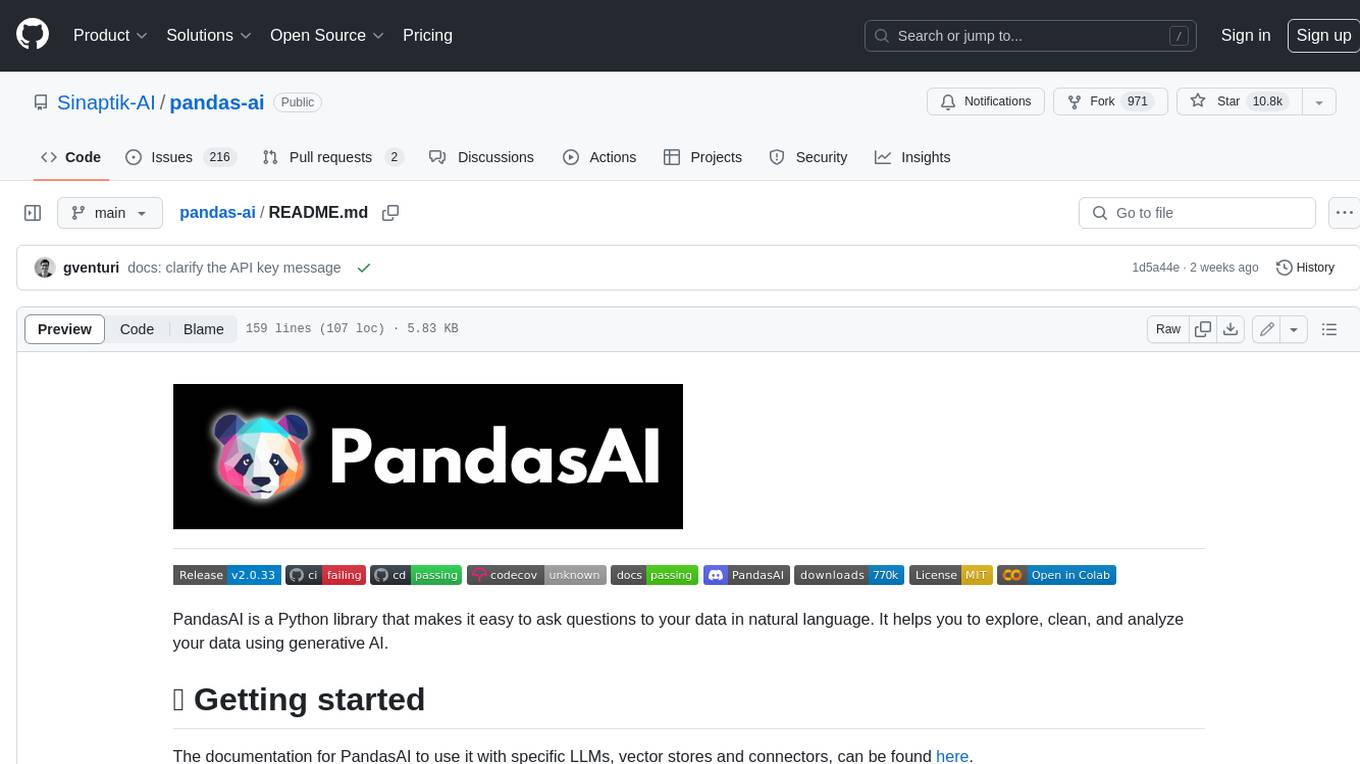
pandas-ai
PandasAI is a Python library that makes it easy to ask questions to your data in natural language. It helps you to explore, clean, and analyze your data using generative AI.
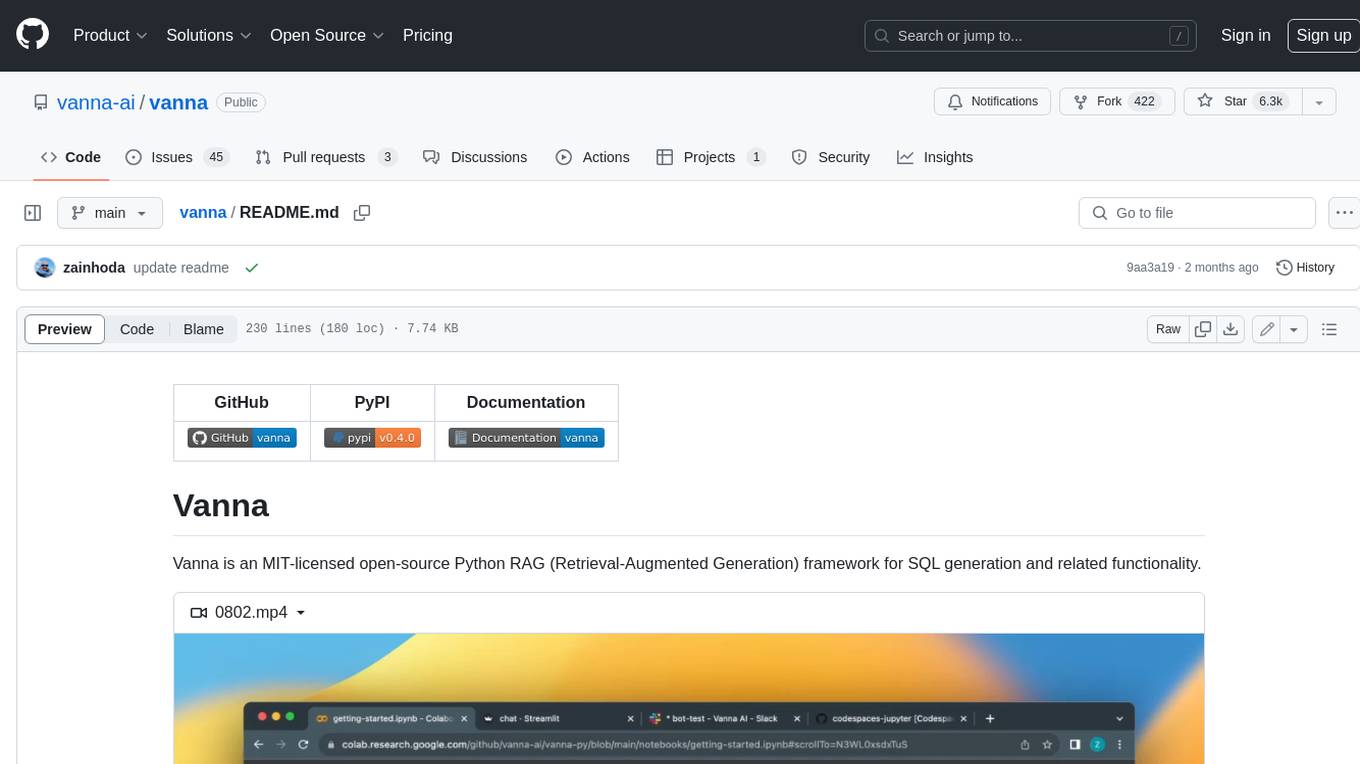
vanna
Vanna is an open-source Python framework for SQL generation and related functionality. It uses Retrieval-Augmented Generation (RAG) to train a model on your data, which can then be used to ask questions and get back SQL queries. Vanna is designed to be portable across different LLMs and vector databases, and it supports any SQL database. It is also secure and private, as your database contents are never sent to the LLM or the vector database.

databend
Databend is an open-source cloud data warehouse that serves as a cost-effective alternative to Snowflake. With its focus on fast query execution and data ingestion, it's designed for complex analysis of the world's largest datasets.
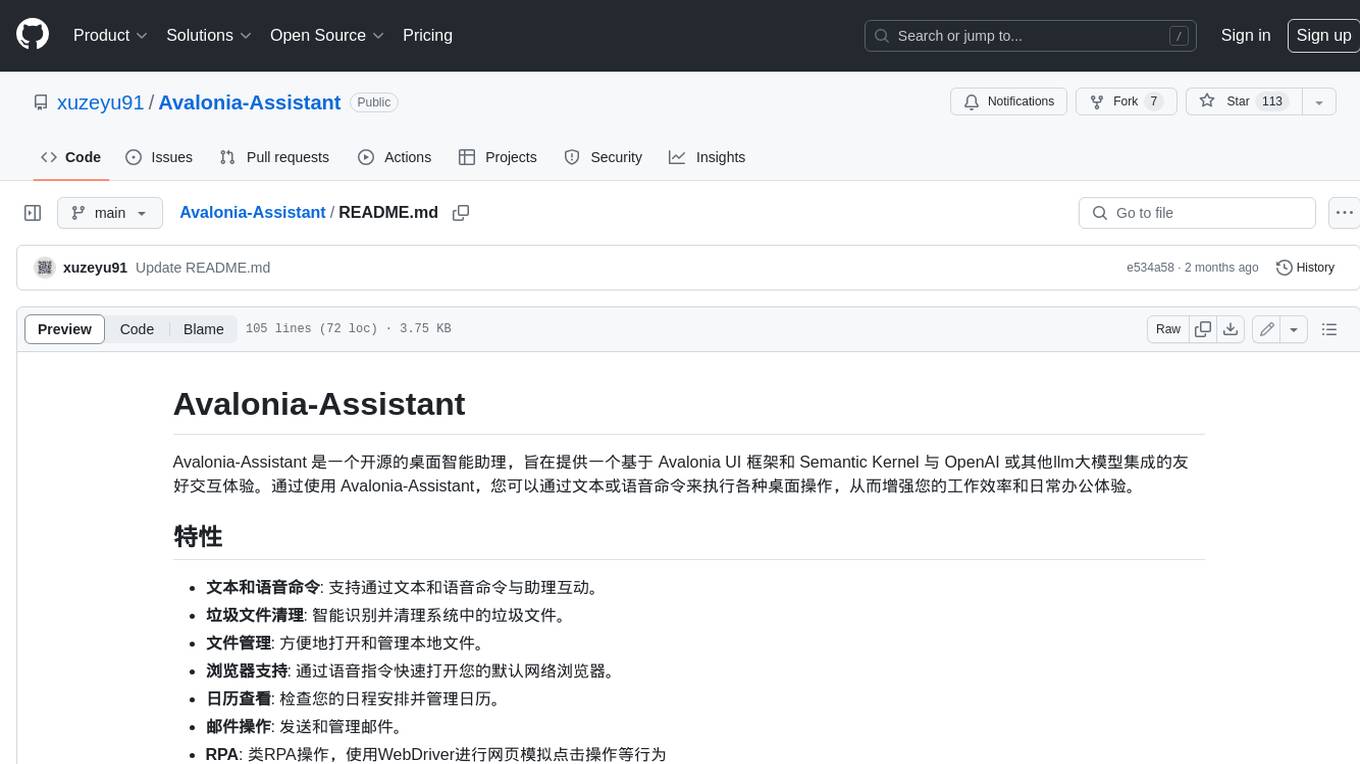
Avalonia-Assistant
Avalonia-Assistant is an open-source desktop intelligent assistant that aims to provide a user-friendly interactive experience based on the Avalonia UI framework and the integration of Semantic Kernel with OpenAI or other large LLM models. By utilizing Avalonia-Assistant, you can perform various desktop operations through text or voice commands, enhancing your productivity and daily office experience.
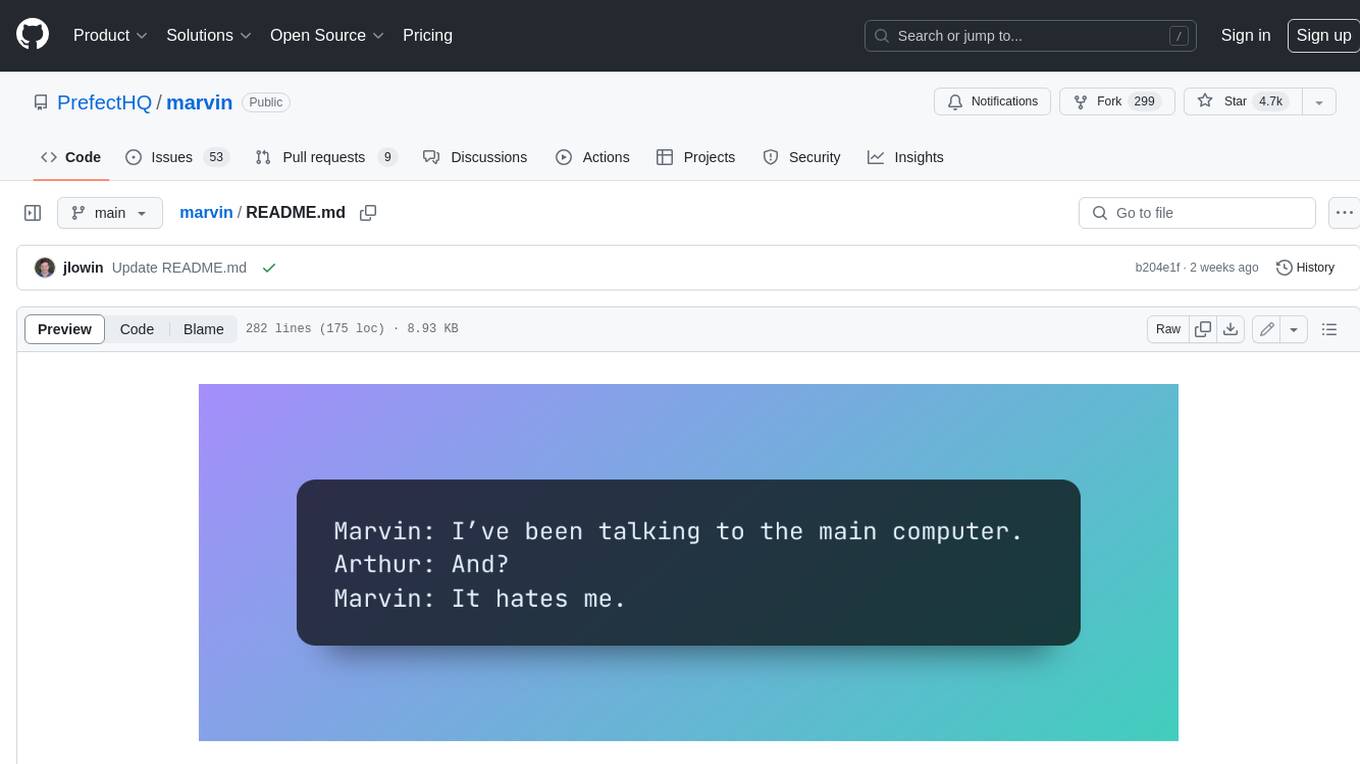
marvin
Marvin is a lightweight AI toolkit for building natural language interfaces that are reliable, scalable, and easy to trust. Each of Marvin's tools is simple and self-documenting, using AI to solve common but complex challenges like entity extraction, classification, and generating synthetic data. Each tool is independent and incrementally adoptable, so you can use them on their own or in combination with any other library. Marvin is also multi-modal, supporting both image and audio generation as well using images as inputs for extraction and classification. Marvin is for developers who care more about _using_ AI than _building_ AI, and we are focused on creating an exceptional developer experience. Marvin users should feel empowered to bring tightly-scoped "AI magic" into any traditional software project with just a few extra lines of code. Marvin aims to merge the best practices for building dependable, observable software with the best practices for building with generative AI into a single, easy-to-use library. It's a serious tool, but we hope you have fun with it. Marvin is open-source, free to use, and made with 💙 by the team at Prefect.
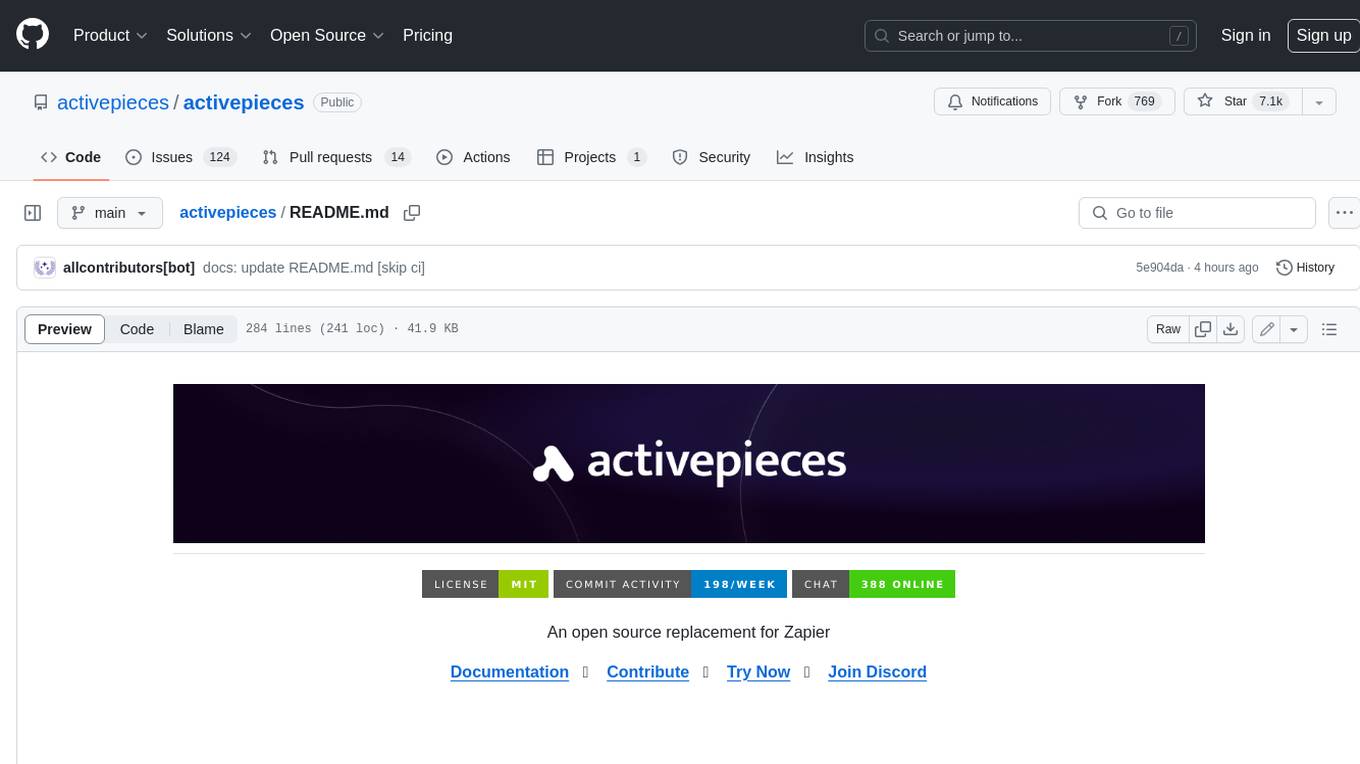
activepieces
Activepieces is an open source replacement for Zapier, designed to be extensible through a type-safe pieces framework written in Typescript. It features a user-friendly Workflow Builder with support for Branches, Loops, and Drag and Drop. Activepieces integrates with Google Sheets, OpenAI, Discord, and RSS, along with 80+ other integrations. The list of supported integrations continues to grow rapidly, thanks to valuable contributions from the community. Activepieces is an open ecosystem; all piece source code is available in the repository, and they are versioned and published directly to npmjs.com upon contributions. If you cannot find a specific piece on the pieces roadmap, please submit a request by visiting the following link: Request Piece Alternatively, if you are a developer, you can quickly build your own piece using our TypeScript framework. For guidance, please refer to the following guide: Contributor's Guide



